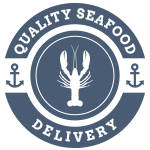Although the climate change discussion commonly revolves around how the human species is affected by rising temperatures, the effect of climate change on the food chain has become a more prevalent discussion. Like many industries, warming ocean waters directly affect fisheries around the world, and the halibut price per pound is no exception. Here are some current prices for halibut to provide context.
2021 Halibut Prices
| Company | Min. Order | Price/lb | Reviews | Rating | Website |
|---|---|---|---|---|---|
| Global Seafoods | 10 lbs | $28.50 | 1,130 | 4.6 | |
| Wulf’s Fish | 1 lb | $29.00 | 764 | 4.9 | |
| Sizzlefish | 3.5lbs | $39.70 | 341 | 4.9 | |
| Lummi Island Wild | .5 lbs | $41.00 | 21 | 4.8 | |
| Fulton Fish Market | .5 lb | $47.20 | 604 | 4.4 | |
| Seabear Smokehouse | 1.5 lb | $53.00 | 273 | 5.0 | |
| Vital Choice | 1.5 lbs | $54.66 | 23,132 | 4.8 | |
| Sea to Table | .6 lb | $51.00 | 2,784 | 4.7 |
How Does Climate Change Affect the Halibut Fish Price Per Pound?
Changes over the last century influence past and present halibut per pound pricing. The rise in greenhouse gas emissions is cause for concern, studies have shown. Studies further indicated that if the emissions were to continue at their 2019 rate, there would be a decline in the overall maximum sustainable catch.
Research published in the journal Science also found that the amount of fish that can be caught yearly dropped by 4.1% from 1930 to 2010. The percentage is a direct result of climate change and was understood to be relevant to the amount of fish that can be caught without putting future catches at risk – otherwise known as the “maximum sustainable yield.”
While these changes remain uncertain, buyers can expect a steady price increase in halibut per pound if these changes to the global climate continue on their current trajectory or worsen.
Government Regulations on Halibut Fishing
Halibut fishing was not always a safe venture. The risks for both fishers and fish were mounting, with many licensed fishers participating in a free-for-all in spite of bad weather. Although done in an effort to maximize results, these experiences often were met with disastrous results. Among these results were sinking boats and necessary rescue missions after storms hit them.
One result was that the Canadian government doubled down and increased regulations. The other predictable consequence was a rise in the halibut price per lb. The government introduced a quota system in 1991. The quota was done in an effort to protect both fishers and the halibut. Ultimately, it gave greater fishing opportunities to licensed halibut fishers on the basis of their vessel size and their catch history.
Prior to the quota, the halibut catch was unloaded rapidly due to a “feast-or-famine” reality. The result was that processors were forced to scramble due to a lack of freezer space availability, which then led to poorer halibut quality and a dip in the overall price.
After the 1991 regulation took effect, the fishing industry witnessed a rise in the fresh halibut price per pound given that fishers could secure higher prices. Their catch could now extend throughout a longer fishing season, which lasts from March to November. Ultimately, consumers faced a new reality where they were perhaps required to pay more, but now it was with the added benefits of improved quality and a wider window of opportunity for purchasing the bottom-dwelling fish.
Yearly Halibut Price Per Pound Trends
Despite indications of a future increase in the halibut market price, there is a general decline in prices in recent years.
The average Alaskan halibut price per pound dropped $0.05 from 2018 to 2019. More notably, there was approximately a $1 drop from 2019 to 2020. The more recent decline was in large part a direct result of the coronavirus pandemic. The pandemic resulted in flattened markets, as well as the fishing industry witnessing processors not buying halibut and others buying limited amounts on consignment.
Take note of our Affiliate Relationships that may exist with this page and companies listed on it.


